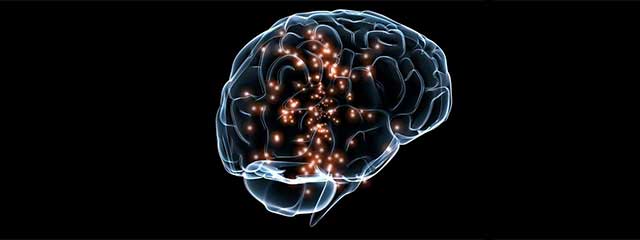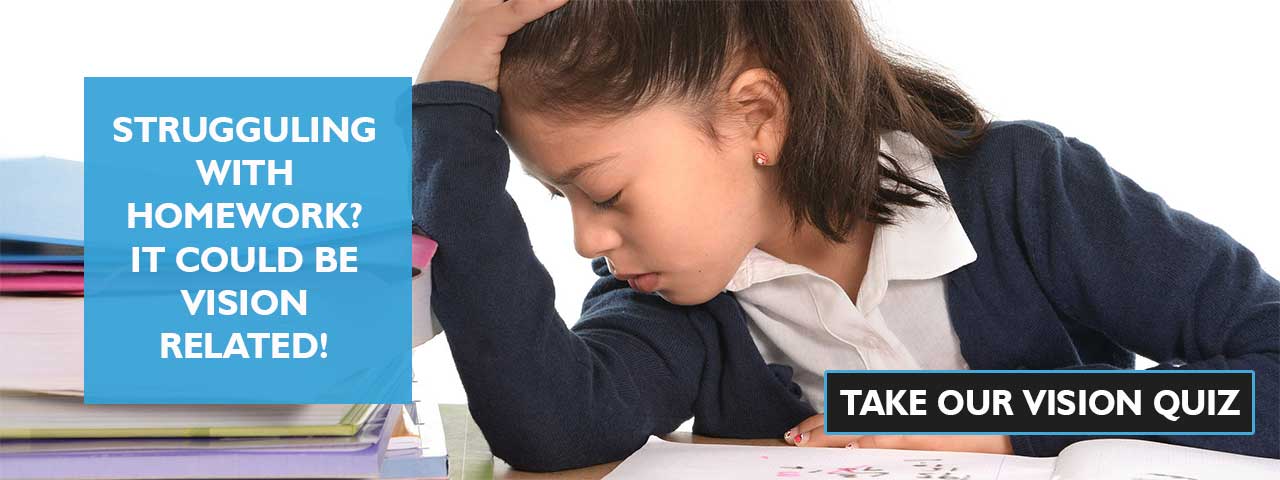
Treatment For Lazy Eye / Amblyopia In Kitchener & Waterloo region, Ontario
What Is Amblyopia?
KW NeuroVision offers vision therapy to effectively treat amblyopia (lazy eye) in children and adults alike, using the latest, proven methods of neuro-optometric therapy and developmental optometry—generally referred to as Vision Therapy. Amblyopia, commonly referred to as “lazy eye”, is a condition where the brain and eyes are not functioning together in unison the way they should. This results in a loss of vision and a significant difference in power between the eyes.
Amblyopia Generally Begins At Birth
Amblyopia generally begins at birth or in early childhood. Since amblyopia doesn’t have any obvious symptoms, it can go unnoticed for years—while the situation deteriorates. Parents and health care professionals are not always aware that there is a problem until the amblyopia is well-established. It takes an experienced and highly-trained developmental optometrist to diagnose amblyopia early-on, and the earlier the diagnosis, the more effectively amblyopia can be treated using Vision Therapy.
Amblyopia Is Often Confused With Strabismus
Amblyopia is often confused with Strabismus (eye-turns), which is further complicated by the fact that amblyopia can be strabismic, although that isn’t always the case. If a person has amblyopia, one eye or the other is deemed weaker by the brain, so it stops processing as much visual information from the weaker eye in order to compensate for the more powerful eye. Sometimes both eyes fail to develop a clear vision. This imbalance or general lack of power in the eyes is called amblyopia.
Amblyopia Leads To Poor Visual Acuity
Amblyopia can cause poor visual acuity, weak eye coordination and poor depth perception. This can result in clumsiness, tripping or knocking into things, and may also lead to difficulties with reading and learning.

Amblyopia Symptoms and Resulting Problems
The common misconception is that amblyopia or lazy eye is always accompanied by a visible misalignment of the eyes. The condition of eyes being misaligned is called strabismus, also called a wandering eye and can often be the cause of the amblyopia. However, amblyopia doesn’t always coincide with strabismus. It is often difficult to detect amblyopia without a proper eye examination.
Amblyopia Often Results In The Following Problems
- Reading and learning problems
- Severe lack of vision in one eye
- Strabismus with exotropia (eye turns to the outside)
- Strabismus with esotropia (eye turns to the inside)
- Double vision
- Cloudy vision in one eye
- Eyes that appear to not work together
- Poor depth perception
- Squinting or shutting an eye
- Head tilting
- Abnormal results of vision screening tests
- Poor depth perception
- Problems with contrast and visual acuity
- Difficulty focusing or maintaining physical focus
- Attention problems associated with ADD/ADHD
What Causes Amblyopia?
Amblyopia is usually caused by at least one of the following three conditions:
- Strabismus, wandering eye, or eye turns, where the eyes fail to align either vertically or horizontally. This is referred to as strabismic amblyopia.
- Refractive issues such as nearsightedness, farsightedness, and distortions caused by astigmatism.
- Congenital Cataracts

Strabismus
Strabismus is also called Crossed Eyes, Wandering Eyes, or Wall Eye. It is the inability to point both eyes in the same direction.
- Esotropia: one eye may turn in relative to the other
- Exotropia: one eye turns out relative to the other.
- Hypertropia: one eye turns up relative to the other
- Hypotropia: one eye turns up relative to the other
The eye turn may occur constantly or only intermittently. If it is constant, that means that it occurs all or much of the time. Intermittent means that it occurs only some of the time, such as only when a person is tired or has done a lot of reading.
It may alternate, which means that at times one eye turns while at other times, it is the other eye that turns.
Strabismus may cause double vision (diplopia). In order to avoid seeing double, vision in one eye may be ignored (suppressed).
If this occurs from birth or soon after, then the ignored eye does not develop the “wiring” or signal to the brain, and this ends up causing a lazy eye (amblyopia). Amblyopia (lazy eye) can occur even if the eyes are pointing straight.
Strabismus is treated by a combination of special eyeglasses, prisms, surgery, or Vision Therapy. The right treatment depends on the cause of the strabismus. Surgery often makes the eyes appear straight, but the visual system is still not balanced between the eyes. Most of the time, lasting and effective treatment for strabismus requires Vision Therapy.

Bilateral & Unilateral Amblyopia
Bilateral Amblyopia ― amblyopia in both channels/eyes ―occurs when the power (prescription) in both eyes is very high.
It's important to correct amblyopia as early as possible before the brain ignores vision in the affected eye. However, amblyopia IS treatable in adults as well. The brain is remarkably plastic, and this plasticity allows for Vision Therapy to be effective even when treating adults with Amblyopia.

Congenital Cataracts
Congenital cataracts are opaque or cloudy coverings which distort vision (cataracts)— they are present from the time of birth. The severity of congenital cataracts can vary from minor to full visual impairment and can occur in one eye (unilateral) or both eyes (bilateral). This condition is usually caused by genetic preconditions and/or metabolic disorders. Congenital cataracts can result in amblyopia, which can persist even after the cataracts are removed.

Vision Therapy For Amblyopia
Retrain Your Neuro-Visual System
Vision therapy is a customized series of exercises and techniques which retrain the neuro-visual system —the interplay between the brain and the eyes. This treatment can include the use of computer programs, games, and various non-digital exercises. As a result, the brain relearns how to properly and effectively operate and interact with the eyes. The vision therapy program can last from as little as 6 months to one year, and is regularly adjusted, based on the progress of the individual patient.
Speak To Our Developmental Optometrists
Speak to Dr. Kimberly Dolman at Dolman Eyecare Centre serving Kitchener & Waterloo region, Cambridge, Guelph, and Stratford. Our staff will be happy to walk you through the process and book your first appointment.
Research on Vision Therapy and Treatment for Amblyopia For Children and Adults
While they have been treating amblyopia for years, the eye doctors are still conducting research to improve upon the current knowledge. The amblyopia project keeps track of many of the articles that publish the results.
The below link is a paper on treating amblyopia.
The below link is a study they did on amblyopia and binocular vision.
https://www.ncbi.nlm.nih.gov/pmc/articles/PMC3577063/
The below link is about treating amblyopia using binocular iPad treatment.
https://www.ncbi.nlm.nih.gov/pmc/articles/PMC4793887/
The below link is about amblyopia and the role of suppression.
https://iovs.arvojournals.org/article.aspx?articleid=2187455
The below link is about amblyopia and the quality of life.
https://www.nature.com/articles/eye20114.pdf
The below link is about the treatment history of amblyopia.
A study of two adult patients whose amblyopia was improved when they're good eye became cataractous.
Improved basic representation using perceptual learning in adults with amblyopia.
http://www.pnas.org/content/101/17/6692.short
Improving positional Acuity with practice in adults with amblyopia.
https://jov.arvojournals.org/article.aspx?articleid=2192867
Restoration and treatment of underdeveloped cortical functions in adults with amblyopia.
https://content.iospress.com/articles/restorative-neurology-and-neuroscience/rnn00450
Adult amblyopia and the prolonged perceptual learning of Positional acuity.
http://www.jneurosci.org/content/28/52/14223.full
Adult Amblyopia: Pattern of Learned Visual Improvement.
https://iovs.arvojournals.orI don'tg/article.aspx?articleid=2165415
Adult amblyopia binary home-based treatment using an iPod.
https://onlinelibrary.wiley.com/doi/full/10.1111/cxo.12192
Improving amblyopic vision in adults through rule-based cognitive compensation using perceptual learning.
https://iovs.arvojournals.org/article.aspx?articleid=2189480
Structure, plasticity, and suppression in adults with amblyopia.
https://onlinelibrary.wiley.com/doi/full/10.1111/opo.12123
Many new scientific studies show that therapy in patients with amblyopia successfully improve eyesight.
http://www.lazyeye.org/lazy-eye-amblyopia-age-treatment-adult.html
Amblyopia Questions And Answers
Does Patching or Atropine Treat Amblyopia?
These treatments may be used together with Vision Therapy, but on their own aren't very effective. This is because patching and atropine do not address the underlying neuro-visual problems which result in the amblyopia in the first place.
Patching is commonly recommended to treat amblyopia, but it’s really an outdated and ineffective treatment. Atropine drops are sometimes recommended in place of patching. The idea behind both patching and atropine is that these treatments “penalize” the good eye, causing the weaker eye to compensate, adjust and gain focus.
The problem with patching and atropine is that they don't treat the underlying neuro-visual cause of the amblyopia.
Patching or atropine drops only address the symptoms. Vision therapy teaches the brain to use both eyes together effectively. This is referred to as “eye-teaming” and improving the ability to team the eyes is essential for an effective and long-lasting treatment of amblyopia. Therefore, the best and most effective solution for treating amblyopia is vision therapy.
Will My Child Outgrow Lazy Eye / Amblyopia?
No. This is a common myth perpetuated by many healthcare providers. Amblyopia does not go away on its own. Untreated, it will significantly and negatively affect a child’s ability to learn, thrive, and function academically and socially. The earlier one receives treatment for lazy eye, the better.
As you get older, eye patching and atropine therapy tend to be even less effective than it is for children. However, Vision Therapy remains effective at any age. While the techniques may take a little longer, Vision Therapy is still a proven treatment method. If you would like to discuss whether Vision Therapy is right for you, contact our caring staff at the KW NeuroVision in Kitchener & Waterloo region, Ontario. Dr. Kimberly Dolman will evaluate your condition and determine the best course of action for you.
Can Adults Be Treated For Lazy Eye / Amblyopia?
Yes. The common wisdom is that lazy eye can only be treated in early childhood. While this is preferable, Vision Therapy can and is effectively used to treat lazy eye in adults as well. The brain is still plastic throughout adulthood and can adapt and change even once it’s fully developed. This means that the Vision Therapy activities and exercises are effective for adults as long as the patient diligently follows the program.
Is LASIK Surgery Useful for Amblyopia?
Ophthalmologists will not typically perform LASIK on the good eye in an individual with amblyopia. The recommended approach is to first have the amblyopia treated using Vision Therapy.
Can I Serve In The Military If I Have Amblyopia?
Probably. There is a list of entry requirements for people with amblyopia, so it depends upon where you fall within these categories. The more severe cases of amblyopia will not be accepted. We recommend scheduling a developmental eye exam to assess your eligibility for military service.
Does Computer Use Make Amblyopia Worse?
There is no direct link between computer use and amblyopia. Computer use, however, is not without its own problems. The blue light from modern LED screens can cause eyestrain, soreness, blurriness, and long-term damage to the retina. Extended computer screen use can also exacerbate the symptoms of dry eye. At the The Vision Therapy Center at Practice Name, we recommend using blue light protective lenses and taking frequent breaks to look at objects at a distance. This applies whether or not you have amblyopia.
How Much Does Vision Therapy Cost?
The cost of Vision Therapy for amblyopia depends on how long and intensive the required treatment is. This will depend on the severity of the amblyopia, age, and how responsive you are to the treatment. There is no single answer for how many treatments will be required. Vision Therapy is customized to each patient’s individuals needs and everyone responds at their own pace.
The most important thing to keep in mind is the cost of NOT getting effective treatment. It can result in a lifetime of difficulty interpreting visual symbols, problems with reading, as well as academic and professional struggles.
Is Vision Therapy For Amblyopia Covered By Health Insurance?
Every medical plan is different. However, for the time being, most Vision Therapy programs are not covered by the majority of medical or vision insurance plans, including OHIP. However, you also need to consider the cost to you or your child’s life success if amblyopia is not effectively treated.
Can I Treat Amblyopia At Home?
There are things that you can do at home, such as eye patching or performing certain eye exercises. However, long-term effective treatment will also require in-office Vision Therapy with an experienced professional. Only a developmental optometrist or vision therapist can assess the progress of your treatment and customize the treatment plan that’s right for you. Home exercises without the ongoing supervision of a vision therapist will have limited success, and is not recommended.


